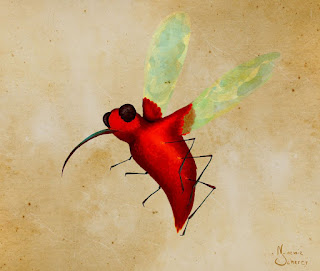lore under the cut:
Centirays:
They’re blind. Touch is their most important sense. They feel their way through the moss and roots with the feelers above their legs. They eat moss and sometimes slow bugs. You can follow them with their trail of about 40cm-wide naked ground path. They climb in trees for the day -when they feel the sunlight coming and the plants reacting to it, they start going towards higher ground till they find a root leading to a tree- and suspend by the tail to sleep, their “wings” wrapped around more vulnerable organs. Their skin is covered by small hair that helps keep soil on their back, and their skin produces a small amount of nutrients; after some time, moss grows too, allowing them to camouflage even better. They live in warm forests with well spaced trees, lots of moss, and no evergreens -needles are hard to digest.
Bloodsucking hummingtoes:
Hummingtoes are about ten centimeters long. They live in big swarms. Their beak injects a soporific liquid when they feed. It’s not very potent, but enough shots can still make any animal fall asleep.
When they’re done feeding, they get sleepy, and usually gather around and over their prey, puff up their feathers for added warmth and sleep till it wakes and shakes them off. It effectively dissuades predators from attacking the weakened prey, and keeps it from dying from the cold. It is a very effective strategy for the hummingtoes too, in the winter, when their own warmth would not be enough to keep them all alive.
They are mostly known to drink blood from big mammals, but fruits can complement their alimentation in spring and summer.
They’re very colorful, usually in some hue of orange-red, so as to tell potential predators it’s a bad idea to mess with them when they're resting over a prey in winter - it could eat a few, but the swarm would win in the end. It is also useful in the summer to camouflage as berries or flowers.
They can migrate quite far if food gets scarce.
Monktopus:
Thanks to their eight limbs, they are very agile. They live in big groups, and often bring food back by using all four of their tentacles and their suckers to make a sort of basket on their back- a time during which they're more vulnerable due to their lessened mobility; as a compromise between food and flight, they can use the suckers to individually grab fruits: it carries less, but doesn't hinder movement.
The babies usually lie on top of the fruit-carrying tentacles-pack and help grab any falling fruit, until they can run by themselves.
They live in tropical forests.
They are actually tail-less. Two of the tentacles attach just below the shoulder blades, and two in the lower back, but none are in the continuity of the spine.
The suckers towards the end of the tentacles tend to have weaker suction than the upper ones, as they get stiffer through constant contact and friction with the branches - except for the last two-three rows, that are not as used for weight support and mobility, and stay nimble.








